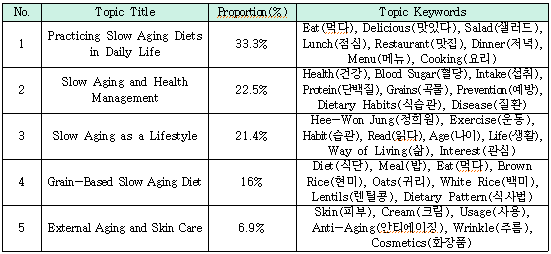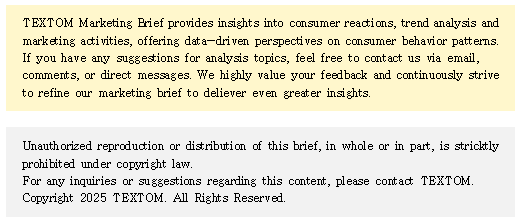Market Opportunities and Challenges Created by the Slow Aging Trend
Keywords : Slow Aging, Hee-Won Jung, Aging, Exercise, Lifestyle, Dietary Habits, Daily Habits, Accelerated Aging, Antioxidants, Grains, Vegetables, Blood Sugar, Food, Fitness, Beauty, Pharmaceuticals, Healthcare, Life Cycle, Anti-Aging, Health, Low Sugar, Topic Modeling, Skin, Whole Grains, Diet, Generation Z, Consumer Response, Trends, Text Analysis
Intro.
In South Korea, the "slow aging" trend, driven primarily by Generation Z, has gained significant traction in 2024, emphasizing dietary choices, exercise, and lifestyle habits to decelerate the aging process. As a result, the food and pharmaceutical industries have actively introduced products reflecting this trend, leading to the expansion of related markets.
This report analyzes the impact of the slow aging trend on South Korean consumers and the evolving market landscape. Furthermore, it explores strategies that relevant industries can leverage to effectively capitalize on this trend.
1. Brief Overview
✅ Analysis Overview and Methodology
✔ Word Frequency Analysis : Calculates the occurrence frequency of words to identify key terms or themes within the text.
✔ N-gram Analysis : Examines patterns of consecutive N words appearing together in a document to uncover common phrase structures.
✔ LDA Topic Modeling : A technique that groups words related to specific themes to uncover hidden topics within documents. The Latent Dirichlet Allocation (LDA) method analyzes the distribution of words within a document to identify multiple underlying topics.
✔ Time Series Analysis : Analyzes sequentially observed data (time series data) to identify patterns and trends and predict future developments. In this report, a linear regression analysis was conducted using the volume of collected data and TF-IDF scores.
✅Dataset Overview
Before delving into the impact and market potential of the slow aging trend, it is essential to define what "slow aging" entails and explore practical ways to implement it.
✅Definition of Slow Aging
✔ "Slow aging" refers to the concept of aging at a decelerated pace. While it is impossible to completely eliminate intrinsic aging factors, the core idea is to adopt lifestyle modifications that help slow down the aging process.
✅Practical Approaches to Slow Aging
✔ Dr. Hee-Won Jung, a professor of geriatrics at Seoul Asan Medical Center, has popularized the concept of “slow aging.” He has emphasized the importance of a diet with a low glycemic index and strength training for achieving slow aging.
He also pointed out the following “brakes” factors that slow aging and “accelerator” factors that accelerate aging.
✔In particular, Professor Jung introduced the Korean-style MIND diet, a slow-aging dietary approach that can be easily incorporated into daily life through traditional Korean meals. In addition to dietary habits, he emphasized the importance of moderating alcohol consumption, quitting smoking, managing stress, getting sufficient sleep, and engaging in both aerobic and strength training exercises.
* MIND Diet : The MIND diet is based on six key principles, 1. Consuming essential nutrients from whole grains, legumes, and nuts. 2. Eating plenty of vegetables and fruits. 3. Using olive oil as the primary source of fat. 4. Prioritizing fish and poultry while limiting red meat, processed meats, and cheese. 5. Reducing the intake of refined grains and simple sugars found in fried foods, snacks, and sugary drinks. 6. Moderating alcohol consumption, with a guideline of up to one glass of wine per day. |
3. Slow Aging Trend
The slow aging trend has been spreading primarily among Generation Z, gaining traction through social media as individuals share photos of their slow aging meals or tips on enjoying healthy food in a flavorful way. Among various slow aging practices, dietary habits appear to attract the most consumer interest.
To gain deeper insights into the dynamics of this trend, we conducted a text analysis to examine its specific patterns and key discussions.
1) Top Slow Aging Keywords capturing consumer attention
✅Strong consumer interest in Slow Aging Diets
✔ “Eat" and "Diet" ranked the highest, suggesting that these terms are likely to be the core topics of discussion in the collected documents. This suggests that among the various slow aging practices (diet, exercise, mental well-being, social engagement, etc.), consumers are most interested in dietary habits.
ㆍThe high TF-IDF scores for "Salad" and "Blood Sugar" further indicate that consumers are particularly focused on vegetable-based meals and low-glycemic diets.
✔ Additionally, “exercise” also emerged as a significant area of consumer interest within slow aging practices. Notably, "Weight Loss" was another frequently mentioned keyword, highlighting the strong association between healthy eating, fitness, and weight management in consumer discussions.
2) Consumer Discourse on the Slow Aging Trend
To understand how the slow aging trend is shaping consumer discourse, we applied LDA(Latent Dirichlet Allocation) topic modeling to identify the optimal number of topics and analyze the underlying themes of discussion. Through this approach, we extracted key discourse patterns and categorized them into distinct topics, providing deeper insights into consumer perceptions and interests related to slow aging.
✅Consumer discourse analysis using LDA topic modeling
✔ Topic modeling results show that Topic 1 (Practicing Slow Aging Diets in Daily Life) accounted for 33.3%, making it the dominant theme in consumer discussions. This suggests that diet is the primary focus of the slow aging trend, with many consumers actively incorporating it into their lifestyles. Discussions on this topic focused primarily on eating out at restaurants that offer slow aging-friendly meals or preparing such meals at home.
3) The Longevity of the Slow Aging Trend
✅A sustained upward trend driven by professor Hee-Won Jung’s advocacy
✔ To assess whether the slow aging trend continues to gain traction among consumers, we analyzed the volume of blog data collected on the topic. The time series regression trend line showed a steady upward trend, suggesting that consumer interest in slow aging is likely to continue.
✅Slow Aging trend expected to continue, focusing on “Diet” and “Health Practices”
✔We analyzed TF-IDF trends for key terms representing slow aging practices-“Diet”, “Health”, “Exercise”, and “Mind”-as well as the highly discussed term “Skin.” This analysis helped identify which slow aging practices were likely to remain at the forefront of consumer interest.
4. The Expansion of the Slow Aging Trend into Secondary Markets
So far, we have examined how the slow aging trend is perceived by consumers, analyzing key areas of interest, discourse patterns, and its continued momentum. Next, we will explore how this trend has given rise to secondary markets and assess their development.
1) Analysis of Secondary Markets emerging from the Slow Aging Trend
To analyze the market segmentation derived from the slow aging trend, we leveraged word frequency data to quantify the relative proportions of each sector.
First, we analyzed the entire keyword dataset and identified food, fitness, pharmaceuticals, and beauty as the key industries influenced by the slow aging trend. Next, we extracted representative keywords for each market from the top 1,000 TF-IDF ranked words. Finally, we calculated each sector’s relative proportion within the slow aging trend based on the average keyword frequency per market.
✅Food, Fitness, Beauty, and Pharmaceuticals: Key Markets driven by the Slow Aging Trend
✔Food Market (35.0%): As healthy eating habits have become a core component of the slow aging trend, the health food industry has emerged as the largest secondary market, driven by demand for low-sugar foods, superfoods, and plant-based diets. A strong preference for products with reduced harmful ingredients, such as ‘low sugar’ and ‘zero’ options, has also been observed.
2) Analysis of Products and Brands Emerging from the Slow Aging Trend
This section analyzes the specific products and brands that have gained traction among consumers in the markets driven by the slow aging trend.
✅Food Market : dominance of salad brands and interest in grain-based convenience foods and cooking tools
✔With a growing emphasis on vegetable-based diets for slow aging, various salad brands have been frequently mentioned among consumers. These brands are gaining popularity as convenient and healthy dining options.
✔As grain-based diets incorporating ingredients like lentils and oats gain popularity for their slow aging benefits, grain-based convenience foods are also attracting consumer attention.
✔In addition to slow aging foods, cooking tools designed for low-sugar meal preparation are also growing in popularity.
5. Strategic Approaches to Leveraging the Slow Aging Trend
✅Food Market : development of customized health foods and subscription-based slow aging diet services
✔As diet remains a central focus of the slow aging trend, the food industry should explore opportunities to expand the health food market by developing grain-based product lines featuring low-glycemic grains such as oats, lentils, and brown rice.
✔Additionally, introducing ready-to-eat meals designed for blood sugar management could further enhance market potential.
✔Furthermore, collaborations between the food and retail industries to offer personalized slow aging diet subscription services based on individual health data could drive long-term consumer engagement and brand loyalty.
Outro.
In this marketing brief, we analyzed the slow aging trend and its emerging markets, products, and brands. No longer limited to traditional health management, the slow aging movement is extending its reach across food, fitness, beauty, and pharmaceuticals, creating new market opportunities. If companies successfully leverage this trend through innovative product development and creative marketing strategies, they can not only strengthen their competitive edge but also enhance consumer well-being by promoting healthier lifestyles. As slow aging continues to reshape long-term lifestyle habits, we anticipate that businesses will seize this opportunity to drive both sustainable growth and social impact, reinforcing their role in shaping the future of wellness.












.gif)

![[Analysis Report] 2023 Israel-Hamas War: Armed Conflict, What is Hamas?](https://blogger.googleusercontent.com/img/b/R29vZ2xl/AVvXsEhDwJo4m2iZHP9UwSwVpkgMMfgtZt9YjXQCOhy6MP2N4rTLv2rEZcW75UCMTSvNOkZffLzU10agTBmAe4vqlzZePtEBdJi9Rq5Q8hmKVDJX1xuqUZcsLmmT9ym4H4HN0khOjLaBScN7DSK084VtRX63Y86eBFZkoe6YiKvA8ueGxj9EkKrSdDCaaE0T2L0/w72-h72-p-k-no-nu/noname01.png)
![[TEXTOM Manual] TF-IDF value calculation formula](https://blogger.googleusercontent.com/img/b/R29vZ2xl/AVvXsEg4A6ez5KZdNO6S57U-KfJFxHaY5T742eGHcB8GBf31otH69vvU3RebrGzIE8T2oMfFKqhqkI5UARdfHx8GP87m7SupOg717haMhorE_u06rz8d0v5fNHrxjEY6mYZKHPfw11nK_EqwLI5fvN2QdiqyPvdQrckeT8QKM2uwu_XdaSutArISjW22AGz7V-c/w72-h72-p-k-no-nu/tyle-y9n-12-1706516180.png)

0 Comments